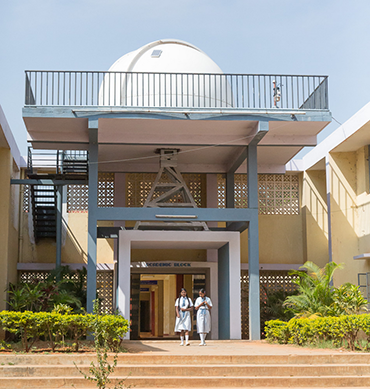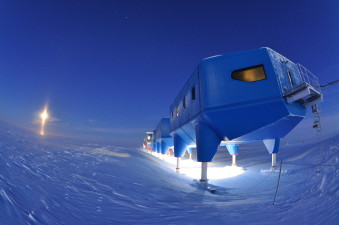Clean Communication Across the Globe
Never before has the ability to send real-time data across expansive spaces been more important. In the wake of the pandemic; remote access to data, and the ability to monitor and control processes from afar, aids communication across vast distances and makes even the most inhospitable environments accessible.
Oxford University’s Global Jet Watch astrophysics project explores how matter behaves in the vicinity of black holes. Five strategically situated telescopes, separated in longitude around the globe, ensure the team are able to collect the right dark matter data at any given time of the day.
At +12° above the equator, the Global Jet Watch observatory in Southern rural India battles debilitating humidity and extremely high temperatures (reaching above 40°C in the hot season.)
As the first such observatory to commission remote observation, it is vital that all of the installed equipment is not only able to integrate with a control panel thousands of miles away, but also reliably withstand the rugged conditions.
Thanks to Brainboxes Ethernet to Serial adapters, as installed in all five of the Global Jet Watch observatories, data from the telescope in India is cleanly and reliably communicated across the globe to the University of Oxford’s Department of Physics in the UK.
An Ethernet connection into the control room, secured by Brainboxes Industrial Ethernet Switches, means that the various diagnostics of the system health can also be monitored remotely from the University headquarters.
Where the Global Jet Watch project faces extreme heat, space weather research conducted by the British Antarctic Survey shows how resilience can be added to remote data capture systems at the other end of the temperature scale.
Built on a floating ice shelf in the Antarctic, the British Antarctic Survey’s Halley VI Research Station collects important data to aid in the study of global problems from climate change and rising sea-levels, to space weather and the thinning of the ozone layer. Thanks to an innovative autonomous power system developed by British Antarctic Survey’s engineers using Brainboxes Analogue Input modules, the station is able for the first time to remotely collect measurements all year-round.
With typical winter temperatures falling below -20oC, extreme lows of -55oC, and 105 days of 24-hour darkness, Halley Research Station’s location is extremely rugged as well as remote. Due to concerns over the stability of the Ice Shelf, the decision was made to staff the station only during summer months.
As the data collected at the station forms part of long-term climate science models, the challenge was to develop a system with the ability to reliably power the suite of scientific instruments year-round. By installing a ground-breaking autonomous power system with a continuous fuel and data feed, the BAS team have managed to secure these measurements without the need for people on the ground. As typical diesel generator technology requires regular monthly maintenance, the BAS engineers elected to install a Capstone Microturbine Generator. With a 9-month period between necessary services, the generator is able to run throughout the winter without requiring maintenance.
This is the first time a Microturbine has ever been used in Antarctica to power instrumentation autonomously. The suite of equipment powered by the system includes; meteorological instrumentation that monitors local weather (such as cloud cover) and longer-term climate, experiments in space weather and upper atmospheric observations, and a Halogen oxide monitor to perform tropospheric chemistry. The remote data capture system is also responsible for the first unmanned measurements collected by the ‘AutoDobson’ – a fully automated model of the instrument that first discovered the hole in the ozone layer.
A major challenge in running the system remotely has been maintaining a continuous supply of fuel to the Microturbine, whilst ensuring a stable temperature inside its housing. External tanks hold approximately 50m3 of fuel and each day the Microturbine requires around 140 litres to be pumped in. To ensure correct levels, and closely monitor against fuel spills, real-time accurate data must be measured and relayed to the BAS network.
Brainboxes Analog Input modules (ED-549) are used to monitor the fuel tank level sensors, current sensors on the pumps, pump pressure sensors – both in and out – and also to measure the fuel flow. Fuel data, levels, pressures and valve positions are all then logged in InfluxDB – an open-source database developed by InfluxData that provides real-time storage and retrieval of data. To visualise historic data, Grafana – a multi-platform open source analytics and interactive visualization web application – allows the BAS engineers to create a complex monitoring dashboard.
The Halley Automation Project aimed to add resilience to the data capture system, whilst simultaneously testing the Microturbine as a proof of concept for future power supply to automated scientific instruments. It has now been successfully running for almost 2 years with the added economic and environmental benefit that the autonomous winter season now consumes only around 10% of the fuel burned through the same manned period.
We were confident we had a good design, but Antarctic winter conditions are brutal, so you never know exactly what might happen. So far the systems have operated in temperatures as low as – 55ºC and withstood wind speeds of up to 70 knots.
Thomas Barningham,
BAS Project Manager at Halley VI
The ability to reliably send usable data across any distance without the constraints of lengthy cabling optimises any environment. Whether in remote locations with extreme conditions, or within the walls of a factory or logistics warehouse, the same principles and technology apply.
RS Components have a Global Next Day Delivery Guarantee which leads to the shipping of approximately one order every second. Any downtime in their warehouse would negatively affect this service, making it vital that faults anywhere on the 5 miles of production line are reported in real-time to the supervisor’s office situated over half a mile away.
By installing Brainboxes Remote I/O Modules to the panel, RS are able to send usable data concerning the cranes’ processes, productivity, and faults to screens across the vast warehouse, into the supervisor’s office, and onto a mobile app. Not only does this make vital information accessible to every team member, but analysis of the data allows RS to identify trends in productivity and adjust their processes accordingly.


